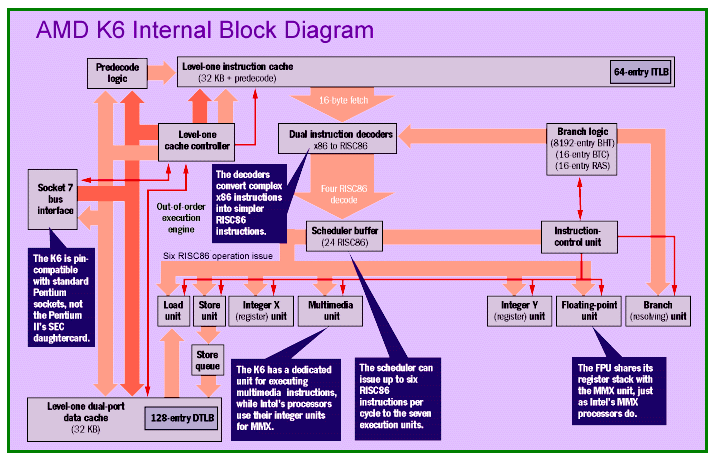| Stuck at 200 MHz since November 1995, x86 processors are
finally ready to break that barrier. AMD was expected to
introduce its long-awaited K6 chip in April at speeds up
to 233 MHz. Sources say Intel will release its Klamath
processor — now officially named the Pentium II — at a
comparable speed in May. And Cyrix says it's still on
track to deliver its M2 at 200 MHz by this summer, with a
233-MHz version to follow later this year. Intel previewed a sixth-generation x86 chip running at 433 MHz at the recent IEEE Solid-State Circuits Conference in San Francisco. Intel claims the chip has reached 451 MHz in the lab. Known as Deschutes, this processor is similar to the Pentium II but is not an official product. To attain those astronomical clock speeds, Intel had to chill the chip to below 32F with a special liquid-cooling system. Intel also modified the computer's motherboard, cranking it up to nearly 96 MHz instead of the standard 66 MHz. The prototype Deschutes runs so hot it won't be practical until Intel makes the transition to 0.28- and 0.25-micron fabrication processes later this year. (The prototype is 0.35 micron.) Smaller process geometries will reduce the operating voltage, and therefore the heat dissipation. Even with these improvements, Deschutes will probably debut at more realistic speeds of 266 to 333 MHz. These power limitations and the general complexity of the x86 architecture account for the long delay in breaking the 200-MHz barrier. The peak power dissipation of a 200-MHz Pentium Pro manufactured at 0.35 micron is a hefty 35 W. Clock speeds much higher than 200 to 233 MHz won't be practical until AMD, Cyrix, and Intel make the transition to smaller process geometries later this year. All the new processors from these three companies are sixth-generation x86 designs with MMX-compatible multimedia extensions. Despite their similarities, however, they have some important differences (see the table). So far, AMD's K6 is the king of complexity. It has 8.8 million transistors — about a million more than a Pentium II, and 3.3 million more than a Pentium Pro. It's by far the most complicated x86 chip ever made. AMD produced the K6 by starting with the nearly complete Nx686 core that the company inherited by acquiring rival NexGen in late 1995. (See "AMD K6 Takes On Intel P6," January 1996 BYTE.) For more than a year, AMD has been tweaking the design to make it compatible with Intel's MMX standard. The original K6 had proprietary multimedia extensions. Initially, AMD is offering the K6 at three speeds: 166, 200, and 233 MHz. Prices (based on 1000-unit quantities) are $244, $349, and $469, respectively. First-quarter pricing for a 200-MHz Pentium Pro ranged from $525 to $1035, but that includes a built-in Level 2 cache (256 or 512 KB), which the K6 doesn't have. AMD claims the K6 is faster than comparably clocked Pentium Pro chips when running the Winstone 97 benchmark on Windows 95. AMD says the K6 matches Pentium Pro performance when running the same benchmarks on Windows NT. The reason for the difference, says AMD, is that the K6 doesn't suffer when running 16-bit code, which is a well-known fault of the Pentium Pro. However, BYTE has not yet been able to benchmark a K6-based system to verify AMD's claims. Currently, AMD is manufacturing the K6 on a 0.35-micron, five-layer-metal process at its foundry in Texas. Later this year, AMD will move to a 0.25-micron process that should boost clock speeds to 266 MHz this fall — and to 300 MHz in 1998. Sixth-Generation x86 Processors

AMD K6 Internal Block Diagram Copyright 1994-1998 BYTE |